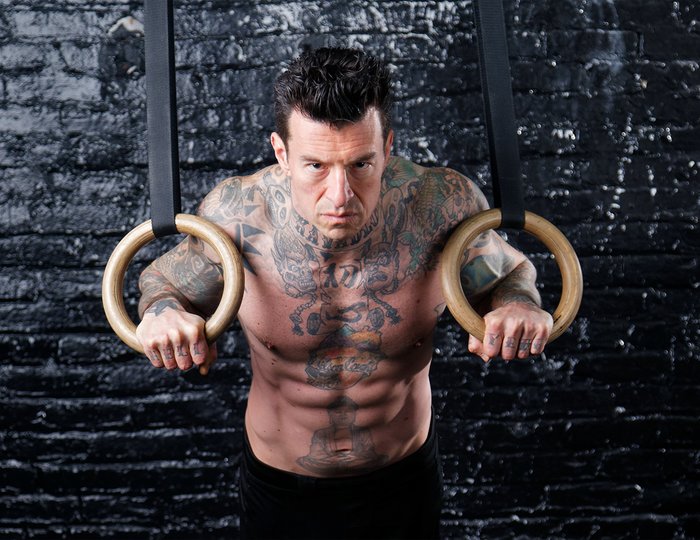A bar and your body. What else do you really need? The fitness minimalists and bodyweight purists out there have been saying "absolutely nothing" for long enough now, it can be shocking to hear anything else.
But in recent years, two longtime staples of gymnastics training, rings and parallettes, have slowly crept out of the Olympic training centers and into mainstream gyms and boxes. The mean part: They have a funny way of taking things you may think you're good at, like pull-ups, dips, or leg raises, and making them instantly way harder. The nice thing? They're very easy to integrate into a home gym, and you can often find some version of them on most playgrounds. Get stronger on them, and you'll also build the type of strength and bodily awareness that can have solid carryover to the bar—and to everything else.
To give insight into why everyone should consider adding rings and parallettes to their workout arsenal, I reached out to longtime Bodybuilding.com contributors Al and Danny Kavadlo, authors of a new guide to these implements, called "Next Level Strength: The Ultimate Rings and Parallettes Program."
You guys are known as diehard minimalists: a bar, the ground, a body. Why bother with rings instead of just a bar?
It's no secret that we're big fans of the pull-up bar! You can do a lot more with a simple straight bar than many people realize. And while many of the exercises in our new book can also be done on a pull-up bar, there are numerous subtleties rendering them quite different on rings.
For example, rings require extra core recruitment. Unlike a fixed pull-up bar, rings are free-floating and unstable. They can swing back and forth, rock side to side, and even rotate. This forces your body to stabilize itself to a greater degree.
Training with rings can also potentially be more forgiving on your joints, particularly those of the wrists, shoulders, and elbows. By allowing your hands to rotate, your joints may move in a more personalized range of motion.

Pull-ups on rings feel…tougher. The reps definitely go down. Ditto for dips and all types of levers. Does it get easier with time?
When you're new to ring training it can be quite a shock to the system! However, with practice your body will adapt and become stronger. But that is true with almost everything: We get better at the things we are used to doing.
That said, dips and pull-ups will almost always be more difficult on rings than when performed on a stable apparatus.
Looking at parallettes, most people think "L-sits." And then they run screaming. What else are parallettes really good for?
Do people really hate L-sits that
Seriously though, elevating your hands with parallettes makes many exercises more accessible than when they're performed on the ground. Often, beginners lack flexibility and/or core strength. Having extra clearance beneath your body can make just enough of a difference to help you nail your first L-sit.
And yes, there are lots of other exercises you can do with parallettes besides the L-sit. Our new book "Next Level Strength" contains lots of moves that most people have never encountered anywhere else, not to mention numerous variations and adaptions of some calisthenics classics.
How can these two tools help people get more out of their bodyweight training? What special skills or strengths do they help develop?
Using rings for exercises like pull-ups and dips forces you to slow down and focus on better control over your movements. It's easier for people to flop around on a stable bar and rely on momentum to carry them through the reps, but you can't really do that on rings.

As for parallettes, wrist pain is one of the most common issues associated with floor exercises like planks, L-sits, and handstands. Since parallettes allow your wrists to maintain a neutral position during these and other exercises, they offer a great way to work around—and possibly help eradicate—any issues that may plague your wrists.
Moreover, squeezing the parallettes while practicing these exercises creates more tension in your upper body, which can facilitate a greater mind-muscle connection. This will help incur greater strength gains, especially with regard to your grip, core, and shoulders.
CrossFit and gymnastics-style training have made these two implements more popular in recent years. But where do people go wrong when they start training them?
CrossFit gets a bad rap from a lot of trainers, but we think it's done a lot more good for the fitness community than it's done harm. One of the best things CrossFit has done is expose more people to bodyweight training, especially with rings.
As far as where people go wrong, the key is to use proper progressions and take your time mastering the basics before moving ahead to more advanced exercises. That's part of why "Next Level Strength" includes a detailed progressive program, warm-ups, "grip tips," and more.
For someone who's done some solid training but not with these tools, what's a good goal or two to aim for?
A strict muscle-up is a great long-term goal for someone who is new to rings. It will take time, but the payoff can be huge. And a full-range-of-motion handstand push-up is a great goal to aim for on the parallettes.
That said, there are many goals worth aiming for and these are just the tip of the iceberg. Check out "Next Level Strength" for much more.

